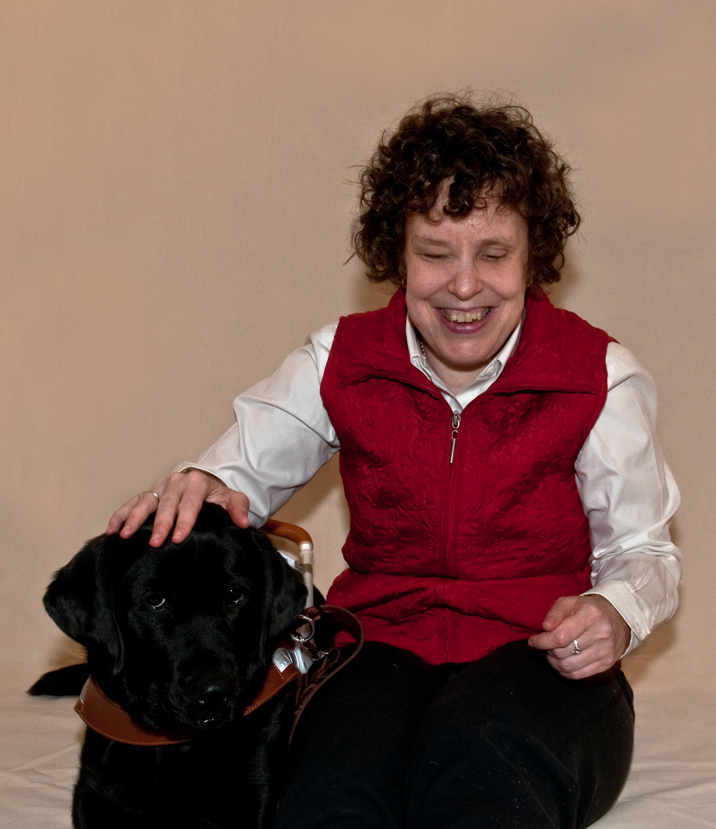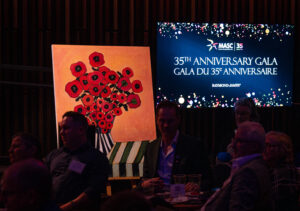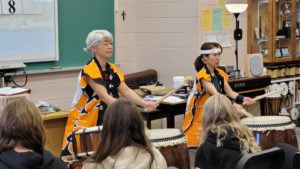Interview: Kim Kilpatrick tells stories to connect with and spark creativity in others
By Jessica Ruano | January 4, 2022

This interview was originally published on Apt613.ca
Kim Kilpatrick tells all types of stories, from folktales to epic material, from historical stories to literary pieces. With over 15 years’ experience as a professional storyteller, Kim is most recognized for her autobiographical works. Her solo shows Flying in the Dark and Raising Stanley / Life with Tulia have been presented across Canada. She is currently working on an online version of her solo shows and a recording with stories and music.
In this interview, Kim talks about living with blindness and creating art during a pandemic, as well as the joy of bringing her guide dog to meet with children in schools!

Kim Kilpatrick with her guide dog. Photo provided by MASC.
MASC: COVID-19 has resulted in a huge increase in demand for guide dogs for the blind, and you have talked about the challenges of living with blindness at a time when physical contact is discouraged. Do you think this period in our history will inspire you to tell new stories about blindness and human connection?
Yes indeed, I do. I think people with disabilities have been lost in the shuffle. I have been waiting for a new guide dog for over a year now and who knows when it will happen. When I tell some people about it, they say, “Well, you’re just staying home, so you don’t really need a dog.” But what would people think if I said that sighted people could just not drive or get a new car? Also, I have to touch things, all things. I don’t know if I am socially distancing or not. When people are speaking from behind plexiglass, it is hard for me to tell where they are.
Also, when I go into a coffee shop with a mask on, I can always tell when others have masks on: Their voices sound different. I stand there and wonder if I am in a line, if I am in the right line, if I am socially distancing. Then I hear a voice bouncing off the plexiglass. Where are they? Right in front of me? Am I facing them? I order my coffee. They say I can tap my card on the glass. They direct like an air traffic controller: “A little to the left. No, a little to the right. Up a little!” Then I hear the beep.
Now I have to get my coffee. It is beyond a little hole in the plexiglass. I don’t want to touch the glass or anything else so I walk over with my cane. Again, the barista is like an air traffic controller. They are so nice and helpful. “Three feet away… two feet… one foot… just to your left.” And then I hear the tapping of the cup against the counter. I have it. Success.
But I can’t drink it because of my mask!

Kim Kilpatrick with her guide dog. Photo provided by MASC.
You became a Paralympian at the age of 14 and won three medals for swimming. What is the connection for you between sports and the arts? How have they both contributed to your sense of self and your activism?
They both gave me the confidence to achieve my goals and to perform under pressure. Also, I learned the importance of having to work hard and put the time into shaping a performance or play or participating in sport. As you prepare, there is a team with you, but when you step out to present in front of an audience, you are alone and have to rise to the occasion. In sports, at that young age, I had role models with disabilities: strong women and men who were confident and competent and did not let their disability get in the way. I also met people with disabilities from many countries and realized how lucky I am to live in Canada where we have access to more services and supports.
As artists and facilitators of arts in the community, what can we do to make our events, festivals, and art works more accessible and engaging to people with disabilities?
There are a lot of things you can do that don’t cost much. You could provide large print and Braille programs or downloadable programs, present your work in accessible venues, and offer live described performances. The best thing you can do is consult with the community. Have people with disabilities involved in the organization who have input on the planning, including staff positions and members of the Board of Directors.
As a member of MASC, what do you gain through offering your workshops in schools and in the community?
It is always such a highlight to perform for MASC. I love the questions that come from school kids. How open and curious they are about blindness and also about our similarities. I love their thoughtfulness and their engagement and their laughter and creativity. I love all age groups and it is always such a pleasure to share my life and stories and get their questions. They always want to pat the dog, which we do at the end – though not these days, of course!
I love the questions that come from school kids. How open and curious they are about blindness and also about our similarities. I love their thoughtfulness and their engagement and their laughter and creativity.
Why do you think it’s important for our local community to have access to professional artists?
I love to think that some of our students would consider the arts as a possible career path. As the arts have been cut in many schools and programs, students do not have as much access. I think it is vital that they meet professional artists, interact with them, get tastes of many art disciplines and art forms, and learn all about them. If one or another form strikes a spark, that is great. Even if they don’t want to be artists themselves, we may inspire them to go to a festival or a play or a gallery, and that is vitally important. We have all clung to the arts in the COVID time. Everyone is watching plays, listening to music, reading books, or watching films from home. Reading poems and telling stories makes us all feel less isolated and more connected.
Latest News
View All Articles



